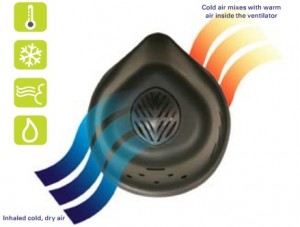Technical Performance
Technical Performance
Wear a ColdAvenger® Stay Out Longer®!
Whether you are an elite athlete, a weekend warrior, have a job that forces you into the cold, or someone with a reactive airway issue like asthma, the ColdAvenger cold weather face mask is an essential piece of cold weather gear for you.
Extended cold air exposure to the facial skin and airways can lead to exercise-induced asthma and other adverse health effects such as rhinorrhea, rhinitis, nasal congestion and cough. Any of these conditions will cause a decrease in performance and focus. Breathing in cold air can also lead to reduced core temperatures. According to the American College of Sports Medicine, the defense against cold-related airway damage and decreased performance is to protect facial skin while increasing warmth and humidity of inhaled air without decreasing airway resistance, especially when breathing rates are high.
The patented ColdAvenger ventilator passively creates (no moving or mechanical parts to break) a “micro-climate” over the mouth and nose. The micro-climate mixes cold air with warm insulated air to create the perfect balance of warmth and humidity of inhaled air. The combination of warmth, humidity and free breathing counter the damaging effect of cold air exposure to the airways. Exhaled moisture binds to the surface of the ventilator to keep your skin dry while returning this moisture to inhaled air, achieving the perfect elevated humidity for the micro-climate.
The size and shape of the ventilator chamber is the key to achieving these performance features.
The ColdAvenger ventilator had been proven to achieve the following six functions:
1) Thermal protection from the elements
2) Free breathing, even during exertion
3) Warm inhaled air
4) Humidify inhaled air
5) Keep the face dry through moisture management
6) Keep goggles from fogging
Real-Time Tests:
Ventilation: A real-time probe measured percent O2 and CO2 inside and outside the ventilator. Percent O2 and CO2 during inhalation and exhalation were very similar to normal control without the mask, indicating more than adequate movement of air through the ventilator and no accumulation of CO2. The O2measured during simulated exercise varied from 21-28% and the CO2 varied from 0.03-3.23%, which are both normal values.
Humidity: Humidity inside the chamber varied from 70-80% with an internal temperature of 66°F compared to outside humidity of 15% and temperature of 5°F.
Resistance: Ease of breathing was tested using a “Dwyer Series 77 Digital Manometer” to measure in-mask pressure during simulated light, medium, and heavy breathing. Fluctuations in pressure were ±5 inches of water, indicating minimal resistance during the heaviest of breathing.
Temperature: Digital thermometry during skiing, jogging, walking and standing demonstrated an in-mask air temperature up to 60°F higher than outside air.
